Practical Solution for Enhanced Drilling Equipment Integrity
In this article, we present a viable two-step solution to keep and improve the technical integrity of drilling equipment without compromising production efficiency and safety.
Perform gap analysis for optimised OPEX and CAPEX
Reactive and planned maintenance regimes are quite common among many companies, yet, the majority of equipment failures are not time-correlated. Aside from the original equipment manufacturer’s (OEM) recommended maintenance schedule, there are several unique factors that should be taken into consideration, as proposed through API RP8B:
Environmental factors:
- Different sea depth: 150m or 1000m?
- Cold or warm climate?
Type of drilling operations:
- Exploration drilling?
- Production well drilling?
- Plug and well abandonment operations?
Load cycles:
- Any drilling-related incidents to consider, e.g., heavy jarring due to stuck pipe problems?
State regulatory requirements:
- Is the asset in compliance with relevant rules and standards of the rig’s location?
Operating time:
- Where in the asset lifecycle is the equipment?
- Close to a CAT IV re-certification survey or recently performed?
Repairs:
- Has the equipment been remanufactured or modified in any way?
GAP Analysis involves the comparison of the operational conditions the equipment is subjected to, the OEM’s suggested timeline of maintenance and repair, and the operator’s existing maintenance programme. It essentially provides operators a foundation for quantifying their investment of time and capital to achieve optimal asset performance.
This practice aims to identify and eliminate non-productive maintenance tasks and replace them with a risk-based inspection programme.

Establish risk-based inspection: best-in-class practices
The American Petroleum Industry (API) defines RBI as a systematic methodology that uses risk as a basis for prioritising and managing an in-service equipment inspection programme by combining both the probability of failure and the consequence of failure. It utilises historical operational data and compliance trends to design an optimised inspection programme that allocates inspection resources to high-risk equipment.
The benefits of RBI include:
- Focused and minimised inspection resources and costs
- Optimised equipment lifetime
- Controlled degradation by analyzing ton-mile calculations
- Maintained technical integrity
Based on the GAP analysis including relevant standards, an RBI analysis should be performed resulting in a RBI inspection programme. In addition, for RBI to work successfully, it requires a versatile and highly skilled inspection team with extensive experience in all types of drilling equipment. The greater the technical expertise on fixed and loose drilling equipment, and the understanding of the relevant standards and regulations, the better the results that in the end influences your drilling performance.
Conclusion
The qualitative and quantitative information obtained from GAP analysis and RBI analysis serves as a basis for developing and implementing a prioritised inspection plan and long-term maintenance strategies. Assisting the asset owner to reduce the need for inspections where the risk of failure is low, and minimising the time-consuming dismantling related to the preparations needed for inspection. Meanwhile, items with higher probability for failure and severe consequences are given more advanced and more frequent inspection, leading to reduced cost and increased safety. Axess Group, a highly competent oilfield service company, provides drilling equipment integrity management for the offshore industry. Our accreditations and qualifications include:
Certified Enterprise of Competence since 2003
- ISO 9001:2008 Certified QA System by DNV (ISO9001 certified since 2001)
- ISO 14001 certified in 2009 for Environmental Management by DNV
- In compliance with ABS/DNV requirements for continuous surveys
- Our team has engineers (BSc, MSc, PhD) with extensive offshore experience and has developed RBI programmes and strategies for several clients, e.g., Det Norske, Shell, Wood Group and Transocean
- Multi-skilled teams offshore – more competence which allows the teams to solve more tasks on-site. Often in a combination of engineers and craft-certified personnel.
- Extensive regulatory knowledge within relevant standards and regulations
- Frame agreement with the Norwegian Petroleum Safety Authority (PSA) for technical evaluation related to investigation and supervision
For more information about our services, contact us at [email protected]